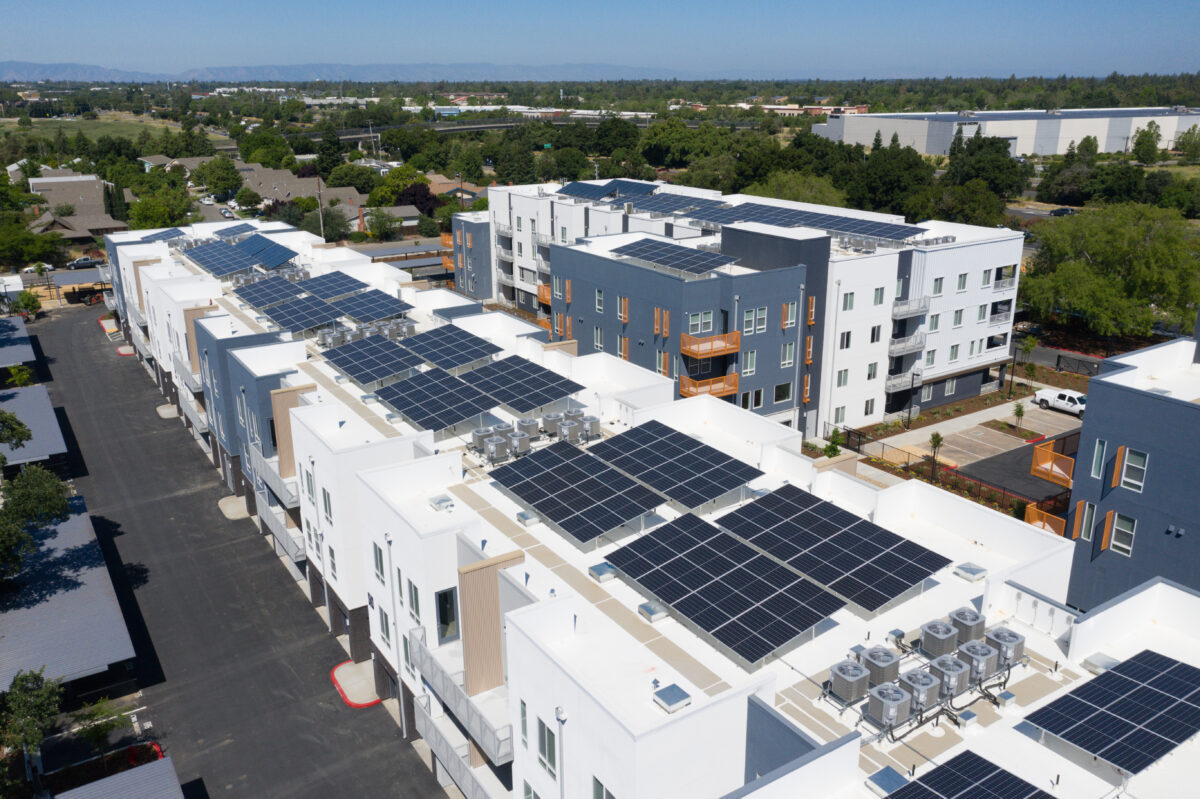Distributed solar installer Aspen Power announced it has completed the initial phase of solar projects for The Michaels Organization, covering a new multifamily housing construction with rooftop PV.
The Davis, California site is expected to generate 476,000 kWh of electricity in its first year of operations, offsetting an estimated 380 metric tons of carbon emissions, equivalent to avoiding burning 781 barrels of oil. The project will meet an estimated 20% of the building’s electricity needs and is expected to save residents an average of 5% on their Pacific Gas & Electric utility bills.
Aspen Power self-originated the project and managed each stage from development and engineering through procurement, installation and utility interconnection. The installer owns the project and is responsible for maintenance of the equipment over the life of the project.
The installation satisfies California’s Title 24 requirements, which mandates multifamily properties to generate renewable energy on-site. Additionally, as of January 1, 2020, all new construction homes, from single-family homes to three-story high multi-family homes, are required to install on-site solar arrays. Exceptions apply to properties with too small a roof or too much shade to be feasible for rooftop solar.
“By incorporating clean energy technology, we can offer our tenants the dual benefits of environmentally friendly power and reduced energy costs,” said Scott Cooper, vice president, The Michaels Organization.
The Michaels Organization has over $11 billion in assets under management and has developed over 57,000 units. It has over 200,000 residents across its 596 housing communities, opening the door for a large commitment to distributed rooftop solar. The company said its business model focuses on solutions to communities that help jumpstart housing, education, civic engagement, and neighborhood prosperity, and has paid over $12 million in resident scholarships to date.
California also voted in 2021 to require the installation of solar and battery energy storage on most new commercial buildings and high-rise residential constructions. The mandate went into effect January 1, 2023, as administered by the state’s Building Standards Commission.
Homes and buildings make up 70% of California’s electricity use and about a fourth of its greenhouse gas emissions, said the Commission. Over 30 years, the Commission estimates the emissions abated from this mandate would equal taking 2.2 million cars off the road.
Acquisition
Aspen Power recently acquired Safari Energy, increasing its exposure to the commercial and industrial solar market. The acquisition came with more than 70 projects in California combining for over 38 MW of solar capacity. The company has stated goals of reaching a GW scale of distributed solar capacity by mid-decade.
The acquisition follows a banner year for merger and acquisition (M&A) in the solar industry in 2022, according to a report by Mercom Capital. Mercom noted that solar funding dipped in 2022, but M&A activity was the highest since 2010.
There were 128 M&A transactions in 2022, with Essen, Germany-based RWE AG’s acquisition of Consolidated Edison’s clean energy group for $6.8 billion representing the largest deal of the year. The Con Edison Clean Energy Businesses consist of 3 GW of operating assets with a 7 GW development pipeline.
In 2022, 66 GW of solar projects changed hands, with developers acquiring a 35.7 GW majority of the assets put on the auction block, representing the second highest project-level acquisitions since 2010.
As for funding in the solar market, $5.9 billion or 84% of equity deals in 2022 went to project development companies, while photovoltaic suppliers raised $864 million and balance of system companies raised $83 million. Intersect Power ($750M), Longroad Energy ($500M), Yellow Door Energy ($400M), Palmetto Solar ($375M) and Aspen Power Partners ($350M) represent the five largest corporate funding transactions in 2022 among the largest funded segment for project development or downstream category.
This content is protected by copyright and may not be reused. If you want to cooperate with us and would like to reuse some of our content, please contact: editors@pv-magazine.com.









By submitting this form you agree to pv magazine using your data for the purposes of publishing your comment.
Your personal data will only be disclosed or otherwise transmitted to third parties for the purposes of spam filtering or if this is necessary for technical maintenance of the website. Any other transfer to third parties will not take place unless this is justified on the basis of applicable data protection regulations or if pv magazine is legally obliged to do so.
You may revoke this consent at any time with effect for the future, in which case your personal data will be deleted immediately. Otherwise, your data will be deleted if pv magazine has processed your request or the purpose of data storage is fulfilled.
Further information on data privacy can be found in our Data Protection Policy.